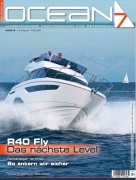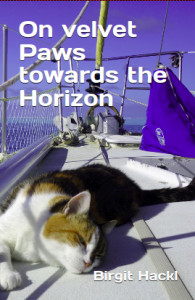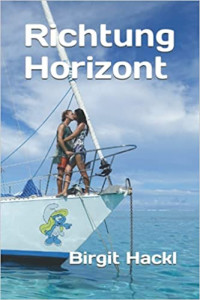On the last day of our passage to Tonga we crossed the date line, so one entire day is missing from our log book and our lives. It adds to the confusion we experience living in the South Pacific: Summer is winter, the South is cold and the North warm, ‘Far East Asia’ lies to the West of us, ‘the West’ (US and Europe) is in the East and now on top of everything today is yesterday… When it’s Friday morning here, it’s Thursday evening in Europe (I hope I got that right, correct me if you’re better at this mindboggling concept ![]() )
)
2016
02
Jul
The day that wasn’t there
2016
28
Jun
Sailing towards Tonga
We really enjoyed our stay in Niue, one day we rented bicycles and explored up north, another day we hitched a ride to the northern cape. The coast is dotted with caves and chasms–we are used to snorkel coral heads, this time we walked between them. We would like to stay a bit longer, but looking at the wind forecast for the next few days we decided to leave for Tonga tonight. We should reach Nuku Alofa in 3 days (320 nm).
2016
27
Jun
More photos: Beveridge Reef

Beveridge Reef
On the way from French Polynesia to Niue we stopped for two nights at Beveridge Reef, a submerged atoll without any motus. Being anchored without land in sight turned out to be a special, but bouncy experience.
(15 photos)
2016
26
Jun
At last some photos again: Maupihaa

Maupihaa
In May 2016 we spent 3 weeks in the tiny atoll of Maupihaa (only 4 miles long). People from Maupiti come and live here to collect copra, currently 15 people live on the island. The hospitality of the islanders and the bird colonies of the western and northern motus made our last stop in French Polynesia a special experience.
(60 photos)
2016
24
Jun
Article about anchoring in Ocean7 magazine

Birgit Hackl, Christian Feldbauer: Ankern — Kinderspiel oder Trauerspiel?, OCEAN7 04 (Juli/August) 2016.
2016
23
Jun
Niue
We arrived today after another fast and rough passage in Niue. Niue is our first ‘Makatea’, a raised atoll–a flat coral plateau surrounded by cliffs. On our trip over the Pacific we sailed by other Makateas several times, but never stopped: Henderson Island close to Pitcairn, Makatea NE of Tahiti (This one gives it’s name to raised atolls), Rurutu in the Austral Islands, Mangaia, Atiu, Mitiaro, und Mauke in the Southern Cook Islands. The bottom drops steeply all around the coast, so anchoring may be difficult, but fortunately the Niue yachtclub has set out buoys, so we’ll stay and explore a while!
2016
23
Jun
Radio Silence
Our HF antenna tuner drowned in its box under the radar arch on the way to Niue–that means no more blog entries and emails from Pitufa under way or remote places. Even worse, we won’t be able to get weather forecasts for a while, but we’ll try to replace asap. So no worries if you don’t read from us whenever we’re away from civilisation.
2016
20
Jun
Beveridge Reef
Beveridge Reef is a submerged atoll, only a ring of coral in the open ocean. It has a wide pass, which we entered at 16:00 o’clock. We crossed the lagoon and are now anchored on the turquoise shelf with no land in sight–just surrounded by a ring of breaking waves. There are no other atolls around, the nearest land is the raised atoll Niue 149 nm away. As fascinating as this place is, it’s still a solemn reminder that if global warming continues at this pace, the sea will soon claim the palm-fringed atolls of the Pacific with their bird colonies and friendly Polynesian population and turn them into landless reef rings like this one.
2016
19
Jun
800 nm in 6 days
We’ve had a swift passage: 800 nautical miles/1480 km in just 6 days. Pitufa is a heavy boat with a relatively short waterline, so she’s best in strong winds, the 20 to 25 knots (37-46 km/h) we’ve had this week were ideal for a downwind passage. Of course strong winds also mean bumpy seas, which makes the life for the human and feline crew a bit uncomfortable. Leeloo got seasick on the first day, but recovered quickly and when we caught a big fish on the third day (a mahi-mahi/dorade big enough to feed all 3 of us for a week) she was already bold enough to climb up to the cockpit despite the rolling boat and shout for her share as soon as she smelled the fish blood on deck.
On downwind passages we have the genoa (foresail) poled out to keep the sail stable and to gain sail area, but when the wind shifts and sometimes comes from the starboard and then again the portside of the stern the foresail must be adjusted accordingly and it used to be a tedious procedure to roll up the sail, rigg the pole on the other side and let the sail out again–especially at night in rough conditions working on deck is splashy, annoying and risky. On this passage we rigged the two poles we carry on both sides of the mast, so sail changes were much quicker and easier.
Last night the wind died down, so we have to motor the last miles to Beveridge reef. Of course it’s annoying to have the Yanmar droning, but on the other hand it’s ideal to reach Beveridge Reef in calm conditions. Many boats on the way to Niue plan to stop there, but most have to abandon the plan, because of rough weather.
2016
18
Jun
Chilly
When we set out from Maupihaa the water temperature was still 28 degrees, but now winter is coming and additionally we’re sailing south, so the water’s now down to ‘chilly’ 25 degrees. After a perfect sailing day week (144 nm/267 km each day) the wind is now slowing down. 160 nm to Beveridge!
2016
17
Jun
Splashy
Pitufa with her high stern is usually a very dry boat when sailing downwind even in high seas. At the moment we have following waves of about 2 m and most of them just rush through under the boat, from time to time one spits up a little bit of spray, but yesterday a bold one managed to break over the stern. Fortunately we had the hatch on the aft deck closed (not tightened), but still some water made it into our bedroom. 300 nm to go to Beveridge!
2016
16
Jun
Change of plans
Yesterday we slowed down in order to reach Aitutaki in the morning, but when we then got a new weatherforecast this morning, we decided to sail on without stopping. We’re now headed to Niue, with a possible stop at Beveridge Reef. 450 nm to Beveridge!
2016
14
Jun
Out again
Yesterday morning the weatherforecast suddenly looked favourable, so we got the boat ready as quickly as possible (still took us 4 hours to clear up) and left Maupihaa at noon. The seas were still a bit rough, but they have calmed down a bit by now. There is more wind than forecasted, so we’ve been doing 6 knots all night long–let’s hope it stays that way! 110 miles done, 240 to go to Aitutaki (Cook Islands).
2016
12
Jun
Pillow fight
The designers of our boat focused on seaworthyness and performance, but didn’t pay too much attention to a comfy sofa–they just built watertanks and then put the cushions on top of them. Sitting on the sofa for a longer time (e.g. an overlenght movie) has always been a real trial for our bottoms. In Tahiti we bought a 5 cm matress which has been waiting in the forecabin for a rainy in-door period. Yesterday we started the project: We cut the thin matress and glued it on top of the old, tough one. The next step was fitting new covers and sewing them together (we still carry a few metres of the fabric we bought in Panama). After two days of fighting with unruly corners and resisting flaps we now have a bum-friendly settee opposite the table in the saloon. As the Pfaff (our trusty sewing machine) was already out to play we manufactured 4 new pillows for our bed and another 4 from the sofa fabric to make the settee even cozier.
2016
08
Jun
The people of Maupihaa
The eastern side of the atoll consists of one long, narrow motu (7km long) and the people of the neighbouring island Maupiti (140 nm away) have divided this land into 75 lots that belong to different families. Most families leave their land unattended, but at the moment 15 people live here. Mostly they stay for a few months, collect as much copra as they can and return to Maupiti (the supply ship only comes twice a year, but some fishing boats bring supplies too and passing sailing boats also get parcels to deliver), but a few live more or less permanently here. Only two houses have solar panels and electricity, most others are very basic, rather open shacks with a cooking place outside, a bucket for a sink and a few matresses.
The people are fabulously friendly and generous. It seems there’s a competition going on who entertains more cruisers (or maybe we are the entertainment for them, as there is no TV, internet or telephone connection here). The first time we went ashore a young guy (Kevin, 26) who lives here alone spontaneously invited us for dinner (it turned out to be a feast with lobster and fish prepared in different varieties), two days later his neighbours (Salome and Ferdinand) invited us over and last weekend the family who lives at the northernmost house (Marcelo, Adrienne and their grown-up kids Hio, Faimano and Buaiti) invited all cruisers (7 boats by now) for a potluck party at their house. The people here spend 6 days a week with hard manual labour (collecting coconuts, cracking them open, pulling the meat out and drying it to produce copra) and Adrienne and her daughters somehow still found the time to collect thousands of shells and make elaborate necklaces which they handed out
to all their guests as welcome gifts. We keep repeating this, but the generosity of the Polynesian people is just amazing.
On Sunday the wind started clocking around (north, then west and back to south) and we moved around the atoll with it, so we got the chance to spend another day at the western motu with its bird colonies and now we’re back in the southeast corner. All boats have flocked to this protected area, because it will blow hard all week. We will do some indoor projects while the cold southeasterly is howling outside, sending best regards from the southern winter.




